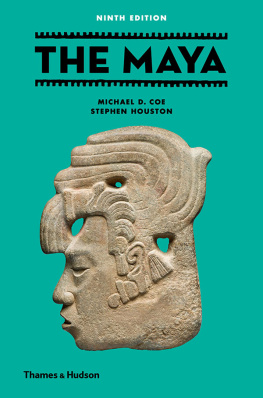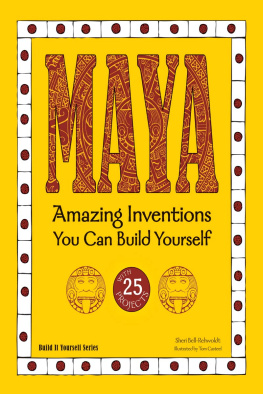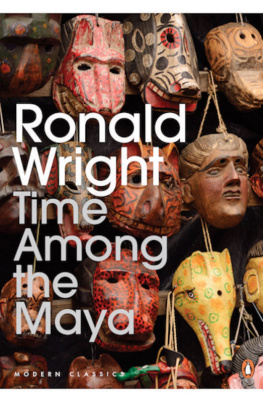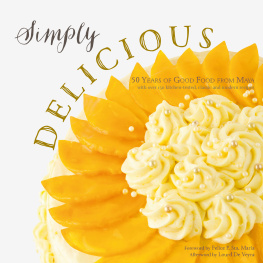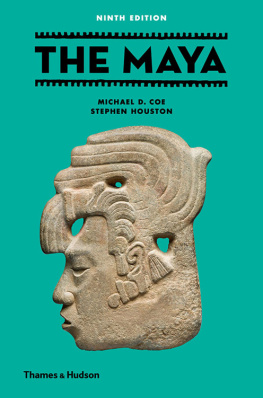
FRONTISPIECE Figure of a dancing king from a wall panel in Structure I3R-5, La Corona, Guatemala. Dedicated 28 October AD 677, this image shows a local ruler, vassal of the powerful dynasty of Calakmul. He wears an elaborate back ornament, labeled paat pihk, back-skirt. Such ornaments often appear with depictions of the dancing Maize God, perhaps alluding to cosmic and geographical motifs. In this back-skirt, the Principal Bird Deity perches on a symbol for sky, from underneath which emerges a snake, an emblem of Calakmul.

Ancient Peoples and Places
Founding Editor: Glyn Daniel
Other titles of interest published by
Thames & Hudson include:
Breaking the Maya Code
Mexico: From the Olmecs to the Aztecs
Angkor and the Khmer Civilization
India: A Short History
The Incas
The Aztecs
See our websites
www.thamesandhudson.com
www.thamesandhudsonusa.com
First published in the United Kingdom in 1966 as
The Maya
Ninth edition 2015
ISBN 978-0-500-29188-7
by Thames & Hudson Ltd, 181a High Holborn, London WC1V 7QX
and in the United States of America by
Thames & Hudson Inc., 500 Fifth Avenue, New York, New York 10110
The Maya 1966 and 1980, 1984, 1987, 1993, 1999, 2005, and 2011 Michael D. Coe
This edition 2015 Michael D. Coe and Stephen Houston
This electronic version first published in 2015 by
Thames & Hudson Ltd, 181a High Holborn, London WC1V 7QX
This electronic version first published in 2015 in the United States of America by
Thames & Hudson Inc., 500 Fifth Avenue, New York, New York 10110.
To find out about all our publications, please visit
www.thamesandhudson.com
www.thamesandhudsonusa.com
All Rights Reserved. No part of this publication may be reproduced or transmitted in any form or by any means, electronic or mechanical, including photocopy, recording or any other information storage and retrieval system, without prior permission in writing from the publisher.
ISBN 978-0-500-77280-5
ISBN for USA only 978-0-500-77281-2 (e-book)
On the cover: The severed head of Huun Ixim, the Maize God, appears in silhouette, a stone version of a belt ornament worn by ballplayers. Photo The Art Institute of Chicago.
CONTENTS

PREFACE
It has been almost fifty years since the first edition of The Maya appeared. Michael Coe wrote the book in the belief that the time was ripe for a concise and accurate, yet reasonably complete, account of these people that would be of interest to students, travelers, and the general public one, preferably, that could be carried in the pocket while visiting the stupendous ruins of this great civilization. In all subsequent editions, he has tried to keep to these goals. As the decipherment of the hieroglyphs proceeded, it became possible to let the Maya express themselves in their own voice, as the previously mute inscriptions began to speak. With that aim in mind, and to represent a younger generation, Coe has brought on board a co-author, Stephen Houston, his student at Yale and another authority on Maya writing and civilization.
In the last decade, the pace of Maya research has quickened to an extraordinary extent. Hardly a week goes by without the announcement of a new royal tomb or discovery, especially at the close of the dry season, when such finds tend to be made. Based upon new research exploring Maya glyphs and iconography, as well as upon technological advances in fields such as remote sensing and paleonutrition, major archaeological advances have been made in Mexico, Guatemala, Belize, and Honduras. We now know a great deal about how to conceptualize Maya societies as the seats of royal courts. Coming into view, too, are the founding fathers of such ancient cities as Copan and El Zotz, and the places from which they came. The historical role of Calakmul looms far larger than imagined by earlier researchers, as does the relative independence of zones like coastal Belize, or the varying nature of societies in areas less endowed with inscriptions. Palenque, which has a history of archaeological investigation reaching back into the eighteenth century, now seems to have had a mighty king (Ahkal Mo Nahb); nothing more to us than a name a decade ago, this ruler was responsible for some of the greatest sculptural art ever produced by the Maya. Perhaps the most exciting new developments in scholarship center upon San Bartolo, in the forests of northeastern Guatemala, where amazing murals dating back two millennia have been discovered the oldest Maya paintings yet known or in sites nearby, such as Holmul and Xultun, celebrated in recent years for their glyphic texts, paintings, and monumental stuccos; Calakmul, with its unique murals of everyday life in a large market; and Ek Balam, an extraordinary site in Yucatan with long painted texts and some of the most astonishing stucco reliefs ever found. These elite remains are matched by an ever more sophisticated understanding of environmental change and modest settlement at places around Xunantunich, Belize, Chunchucmil in Yucatan, or the ancient kingdom of Palenque and its neighbors. Yet some puzzles still remain to be solved: above all, the nature of Preclassic civilization, the features of Maya society in Highland Guatemala, and what really happened during the transition between the Classic and Postclassic periods. Was there truly a Toltec-Maya occupation of the huge site of Chichen Itza? Unfortunately, until the day that Chichen becomes treated more as a major site crying out for broad-scale excavation, and less as a venue for mass tourism, those questions will not be answered.
Here we have relied on the advice and learning of numerous colleagues, including those who have recently passed away, especially Pat Culbert, Peter Harrison, Barbara Kerr, Juan Pedro Laporte, Enrique Nalda, Juan Antonio Valds, and Houstons first professor of all things Maya, Robert Sharer. We are particularly indebted to Thomas Garrison, Takeshi Inomata, and Scott Simmons, who gave useful comments on many points in the manuscript. Others on whom we have relied for new information (but they may not always know this!) are Jaime Awe, Tim and Sheryl Beach, Marcello Canuto, Arlen and Diane Chase, Ramn Carrasco, Oswaldo Chinchilla Mazariegos, John Clark, George Cowgill, Francisco Estrada-Belli, Claudia Garca-Des Lauriers, Charles Golden, Heather Hurst, Scott Hutson, David Joralemon, Justin Kerr, Brigitte Kovacevich, Rodrigo Liendo Stuardo, Simon Martin, Sam Merrin, Mary Miller, Sofa Paredes Maury, Jorge Prez de Lara, Michelle Rich, Rob Rosenswig, Frauke Sachse, Catharina Santasilia, William Saturno, Andrew Scherer, David Stuart, Karl Taube, Alex Tokovinine, Ben Watkins, David Webster, Brent Woodfill, Marc Zender, and Jarosaw raka. However, if there are mistakes in this book, they are ours alone.
A word about words: here, glottalized consonants are indicated by a following apostrophe (as in kahk, fire). The only exceptions to these new rules will be the names of sites so well known in the literature, and to students and tourists, that it would be confusing to change their spelling (such as Tikal, which logically ought to be Tikal). Throughout, vowels have about the same pronunciation that they have in Spanish; long vowels are indicated by doubling, as in

